Suchergebnisse
Freiformflächen-Tageslichtsysteme für Fassaden und Oberlichter (FFF-TaliSys)

Im Rahmen von FFF-TaliSys wurden neuartige Tageslichtsysteme auf Basis der Freiformflächentechnologie erarbeitet und bis zu Funktionsmustern weiterentwickelt. Innovative Systeme sollen die widersprüchlichen Anforderungen an Tageslichtsysteme bestmöglich lösen.
Schriftenreihe
34/2019
C. Knoflach, D. Plörer, R. Weitlaner
Herausgeber: BMVIT
Deutsch, 47 Seiten
Downloads zur Publikation
PowerShade – Entwicklung stromgenerierender Beschattungslösungen für energieflexible Gebäude im urbanen Raum
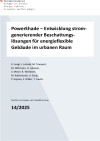
Ziel des Projektes "PowerShade" war die Entwicklung von kostengünstigen und universell einsetzbaren stromgenerierenden Beschattungslösungen, welche durch intelligente Regelung gekoppelt mit künstlicher Intelligenz eine Steigerung der Energieflexibilität von Gebäuden im urbanen Raum ermöglichen.
Schriftenreihe
14/2025
D. Sengl, J. Leibold, M. Trampert, M. Wittmann, G. Lukasser, S. Moser, R. Weitlaner, M. Kobelrausch, A. Estaji, Z. Kujawa, S. Wilker, T. Sauter
Herausgeber: BMK
Deutsch, 62 Seiten
Downloads zur Publikation
Cooling LEC – Energieflexible Gebäude durch Steuerung von Kühlanlagen über unidirektionale Kommunikation in Local Energy Communities
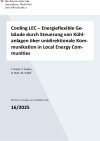
An das Stromsystem (insbesondere an das Verteilnetz) werden in Folge des Klimawandels und des Temperaturanstieges insbesondere durch den Anstieg aktiver Kühlsysteme vor allem auf Niederspannungsebene neue Herausforderungen gestellt. Durch die hohe elektrische Leistung von aktiven Kühlaggregaten und die hohe Dichte an Anlagen, die mitunter unkoordiniert und zu ungünstigen Zeitpunkten betrieben werden, entstehen Verbrauchsspitzen im System. Das Projekt Cooling LEC weist daher als übergeordnetes Ziel die Entwicklung und Demonstration einer zentralen Steuerung / Intelligenz von dezentralen aktiven Kühlanlagen über eine Weiterentwicklung der unidirektionalen Kommunikation von Rundsteueranlagen zur Schaffung energieflexibler Gebäude im Sinne des neuen Ansatzes der "Local Energy Communities” durch Schaffung eines "Sondertarifs"aus. Rundsteueranlagen sind seit vielen Jahrzehnten etabliert und bei allen Energieversorgern vorhanden sowie bewährt. Das Upcsaling-Potential ist sehr groß.
Schriftenreihe
16/2025
T. Nacht, R. Pratter, N. Bisko, M. Kröpfl
Herausgeber: BMIMI
Deutsch, 54 Seiten
Downloads zur Publikation
mAIntenance – Untersuchung von KI gestütztem Instandhaltungs- und Energiemanagement
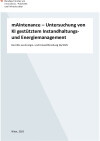
Optimierter & zuverlässiger Betrieb von Heizungs-, Lüftungs-, Klima- und Kältetechnik (HLKK) Anlagen hinsichtlich Instandhaltungs- und Energiemanagement mittels prädiktiver, datenbasierter & selbstlernender Fehlererkennung. Konzeptioneller Entwurf und prototypische Implementierung eines KI (Künstliche Intelligenz)-Tools zur automatisierten Datenanalyse und Empfehlungsgebung für das technische Gebäudemanagement.
Schriftenreihe
46/2025
Jerik Catal, Fabrizia Giordano, Jan Kurzidim, Michael Schöny, Miloš Šipetić, Thomas Lachmayer, Anna Maria Nujic
Herausgeber: BMIMI
Deutsch, 75 Seiten
Downloads zur Publikation
greening UP! Nachhaltige Grünpflege, Wartung, Instandhaltung von Vertikalbegrünungen inklusive rechtlicher Aspekte
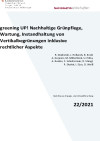
Im Projekt wurden aufbauend auf umfassenden Erhebungen und Analysen von bestehenden vertikalen Gebäudebegrünungen in Außenräumen (boden- und systemgebundene Fassadenbegrünungen) und vertikalen Innenraumbegrünungen passgenaue Grünpflege-, Wartungs- und Instandhaltungskonzepte erarbeitet und rechtliche Aspekte adressiert. Der "greening UP!"-Wissenspool mit konkreten Empfehlungen und anschaulich aufbereitetem Wissen sowie die Konzeption eines digitalen Tools zur "Ersten Grünen Hilfe" runden das Projekt ab.
Schriftenreihe
22/2021
R. Dopheide, J. Hollands, B. Knoll, A. Korjenic, M. Mitterböck, U. Pitha, A. Renkin, F. Schiefermair, R. Stangl, P. Skolek, I. Süss, O. Weiß
Herausgeber: BMK
Deutsch, 162 Seiten
Downloads zur Publikation
Vertical Farming: Ermittlung der Anforderungsbedingungen zur Entwicklung eines Vertical Farm-Prototyps zur Kulturpflanzenproduktion
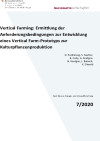
Im Mittelpunkt stand die Erforschung von Grundlagen für eine neue Gebäudetypologie, der Vertikalen Farm. Urbane vertikale Lebensmittelproduktion kann zur Steigerung der Energieeffizienz von und zur Reduktion des Landverbrauchs durch Städte beitragen. Wesentliche Einflussfaktoren zur Erreichung dieser Ziele werden durch diese Grundlagenforschung offen gelegt.
Schriftenreihe
7/2020
D. Podmirseg, S. Sautter, B. Cody, A. Keutgen, N. Keutgen, J. Balasch, K. Diwold
Herausgeber: BMK
Deutsch, 91 Seiten
Downloads zur Publikation
Technologiereport: Digitalisierung der Bau- und Immobilienbranche
In der Vielzahl digitaler Möglichkeiten ist es nur sehr schwer möglich, einen Überblick zu behalten, Trends und Potentiale abzuschätzen sowie Zusammenhänge zu erkennen. Der vorliegende Report zielt daher darauf ab, den aktuellen Stand der Technik und die Markteinschätzung vielversprechender digitaler Technologien zu beschreiben. Es werden Informationen über konkrete Anwendungsfälle, Mehrwert und Herausforderungen der jeweiligen Technologien bereitgestellt. Die dargestellten Analysen dienen der Potentialbewertung und der strategischen Weichenstellung zur Integration der aktuell wichtigsten digitalen Technologien der Bau- und Immobilienbranche.
DW² - Entwicklung einer thermisch verbesserten Schlitzwandkonstruktion
Die thermischen Eigenschaften von Schlitzwandkonstruktionen werden durch die Anwendung neuer Materialien und Herstellungsmethoden verbessert und durch Labor- und Feldversuche validiert sowie durch numerische und ökologische Betrachtungen ergänzt. Das Ergebnis kann bei der Errichtung von energetisch verbesserten unterirdischen Bauwerken wie beispielsweise Tiefgaragen oder zur Herstellung von Erdwärmespeichern verwendet werden.
DW² - Thermal improvements on diaphragm walls
New materials and installation methods for diaphragm walls will be investigated in laboratory and field tests in order to improve the thermal properties of the construction elements. Additional numerical and ecological aspects are considered to ensure an energetic enhancement of underground constructions such as underground garages or thermal energy storages.
HotCity - Gamification als Möglichkeit für die Generierung von Daten zur energieorientierten Quartiersplanung
Ziel des Projekts war ein Funktionstest, ob durch Gamification kosteneffizient, rasch und zuverlässig ein aktueller Datensatz von energierelevanten Daten zur Quartiersplanung erhoben werden kann. Dies wurde am Beispiel der Potenzialermittlung von industriellen und gewerblichen Abwärmequellen in Wien und Graz ermittelt.
HotCity - Gamification as a possibility to generate data for energy-oriented neighbourhood planning
The aim of the project was a functional test to determine whether an up-to-date data set of energy-oriented data can be collected for neighbourhood planning through gamification, cost-efficiently, quickly and reliably. This had been determined using the example of the potential determination of industrial and commercial waste heat sources in Vienna and Graz.
BiBi-TGA - Potenzial der ökologischen Optimierung technischer Gebäudeausrüstung durch den Einsatz biogener Materialien
Erhebung des Substitutionspotenzials herkömmlicher Komponenten der technischen Gebäudeausrüstung durch biogene Materialien. Ziel war die Generierung neuer Daten zum ökologischen Verbesserungspotenzial des Einsatzes biogener Ressourcen in der technischen Gebäudeausrüstung in Bürogebäuden. Anhand von LCA-Screenings und Untersuchungen der technischen Umsetzbarkeit wurden die Potenziale analysiert.
BiBi-TGA, Potential for the ecological optimization of technical building equipment through the usage of biogenic materials
Assessment of the substitution potential of conventional components of technical building equipment by biogenic materials. The aim is to provide new data on the ecological improvement potential of the usage of biogenic resources in the technical building equipment in office buildings. The potentials are analyzed by means of LCA screenings and technical feasibility studies.
Multi-WP - Hocheffiziente multivalente Wärmepumpenkonzepte zur thermischen Nutzung von Außenluft mit geothermischer Speicherung
Optimierung von Multi-WP-Systemen bestehend aus Luft-Wärmepumpen und Erdspeichern im Hinblick auf Erhöhung der Flexibilität und Effizienz ab 30 kW für Einzelgebäude sowie Quartierslösungen und Behandlung von Aspekten wie PV-Nutzungsoptimierung, Betriebsweise, Nutzungskonflikte und Lärmbelastung durch Luftwärmepumpen. Das Projekt wird die Nutzung der Wärmequelle Außenluft in Kombination mit Saisonspeichern als besonders effiziente Alternative für Heizung, Kühlung und Warmwasserbereitung etablieren.
Multi-WP – High-efficiency multivalent heat pump concepts for the thermal use of external air with geothermal storage
Optimization of multi-WP systems consisting of air-source heat pumps and geothermal storage with regard to increasing flexibility and efficiency from 30 kW for individual buildings as well as neighbourhood solutions and addressing aspects such as PV utilization optimization, mode of operation, utilization conflicts and noise pollution from air-source heat pumps. The project will establish the use of the heat source external air in combination with seasonal storage as a particularly efficient alternative for heating, cooling and hot water supply.
OptiMAS - Optimization of building energy efficiency through model-based energy flow analysis with non-invasive sensors
Using a model-based energy flow analysis supported by non-invasive sensor technologies OptiMAS investigated how to monitor, analyze and optimize existing buildings independent of the installed HVAC systems and automation components. With the OptiMAS approach the optimization potential of individual buildings up to entire areas can be detected, located and tapped by adjustment of system parameters to ensure highest energy and resource efficiency.
FEELings - User Feedback for Energy Efficiency in Buildings
Der Energieverbrauch von Gebäuden wird maßgeblich durch das Verhalten von NutzerInnen beeinflusst. In diesem Forschungsprojekt wird ein neuartiges User-Feedbacksystem untersucht. NutzerInnen geben Feedback zur empfundenen Raumqualität. Auf Basis des Feedbacks werden Einstellungen an der Gebäudetechnik zur Energieeffizienz- und Komfortsteigerung optimiert. Der Proof-of-Concept für dieses neuartige System wird anhand von zwei Use-Cases erbracht.
FEELings - User Feedback for Energy Efficiency in Buildings
User behavior is a key factor for the energy consumption and the actual energetic performance of a building. A new type of user feedback system will be investigated in this research project. Users provide feedback on the sensed room quality. The data obtained by the feedback system are used to optimize settings of building services in order to improve the energy efficiency and the comfort in the building. A basic proof of concept of this system will be undertaken by means of two use cases.
metaTGA - Metadaten und Prozessmodelle für Open BIM in der TGA
Ziel dieses Projektes ist es, eine Methodik für die Entwicklung von Daten- und Prozessmodellen zu konzipieren und diese zur Modellierung ausgewählter TGA (Technische Gebäudeausrüstung)-Systeme exemplarisch anzuwenden. Dazu werden schwerpunktmäßig, jedoch nicht ausschließlich, die erneuerbaren Heizungstechnologien Wärmepumpe, Solarthermie und Biomasse sowie Lüftungssysteme betrachtet. Die entwickelten Daten- und Prozessmodelle werden im Rahmen von zwei Pilotprojekten evaluiert. Die Projektergebnisse werden in einem TGA-BIM-Leitfaden publiziert und in BIM-Arbeitsgruppen in relevanten Gremien eingebracht.
metaTGA - Metadata and process models for open BIM in building service engineering
The objective of this research project is to design a methodology for developing data and process models and to apply them by modelling selected MEP systems. A particular but not exclusive focus is put on the renewable heating technologies, e.g. heat pumps, solar heat and biomass as well as ventilation systems. The data and process models developed in this research project will be scientifically evaluated in two pilot projects. The models, the approaches taken during development and the project team’s experiences with the pilot application of the models will be disseminated openly.
